Ferns of the Adirondacks:
Maidenhair Fern (Adiantum pedatum)
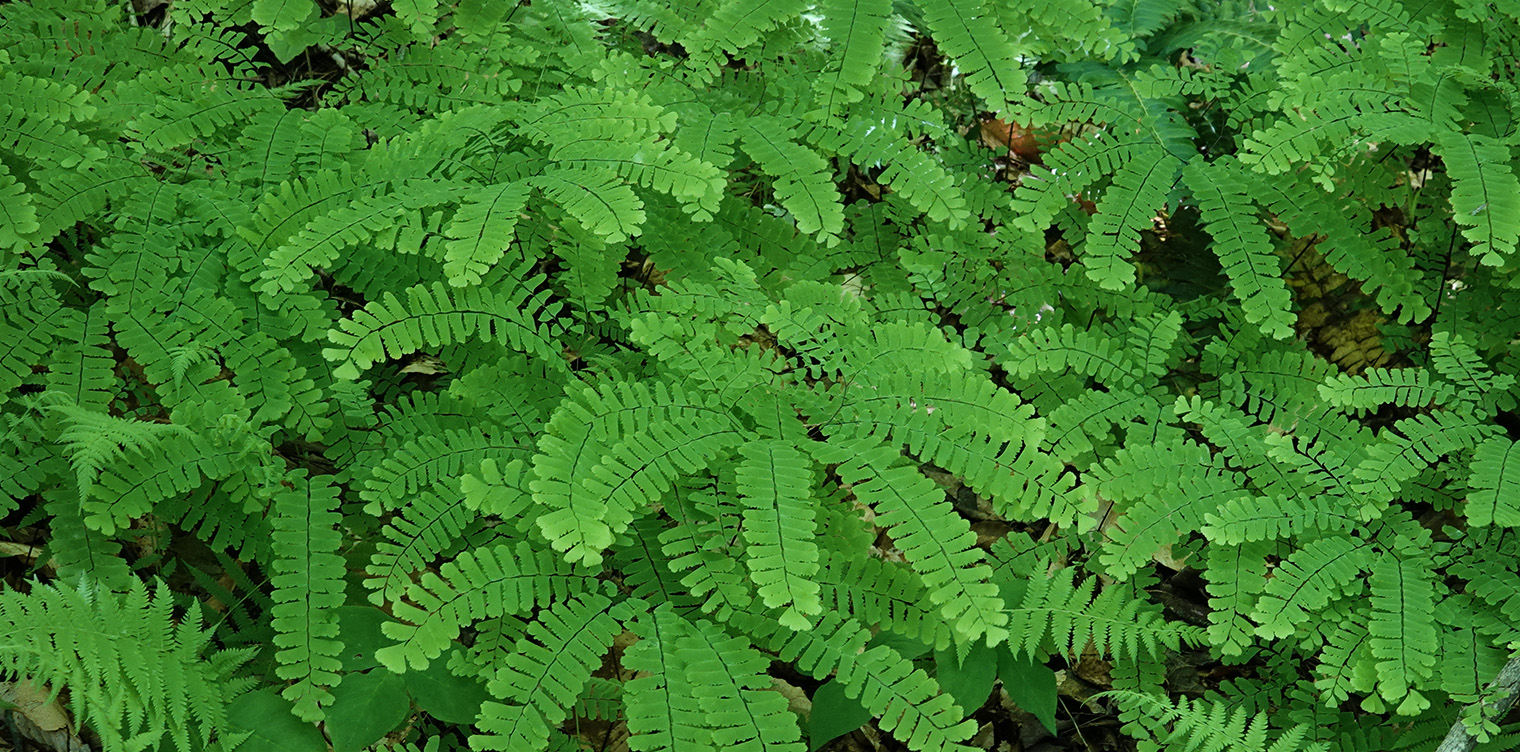
Maidenhair Fern (Adiantum pedatum) is a deciduous fern that grows in northern hardwood forests in the Adirondack Mountains of New York State.
Maidenhair Fern is assigned to the Adiantum genus, a large genus with 150 to 200 species worldwide. Most are tropical species; only nine species are found in North America. Maidenhair Fern (Adiantum pedatum) is the only member of this genus found in the Adirondacks.
- The genus name (Adiantum) is derived from the Greek word"adiantos" meaning "unwetted" – a reference to the way the fronds repel water.
- The species name (pedatum) is from the Latin "footed," meaning "like a bird's foot." This refers to the
pinnae
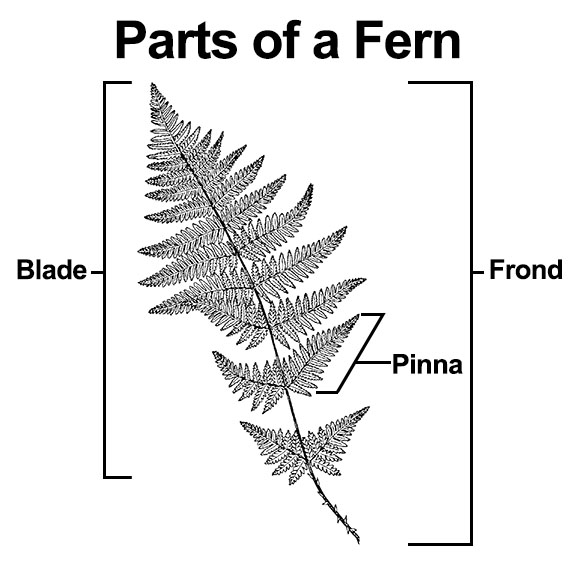 Pinna: A primary division of the blade (plural: pinnae).
which radiate outward from the horseshoe-shaped
rachis
Pinna: A primary division of the blade (plural: pinnae).
which radiate outward from the horseshoe-shaped
rachis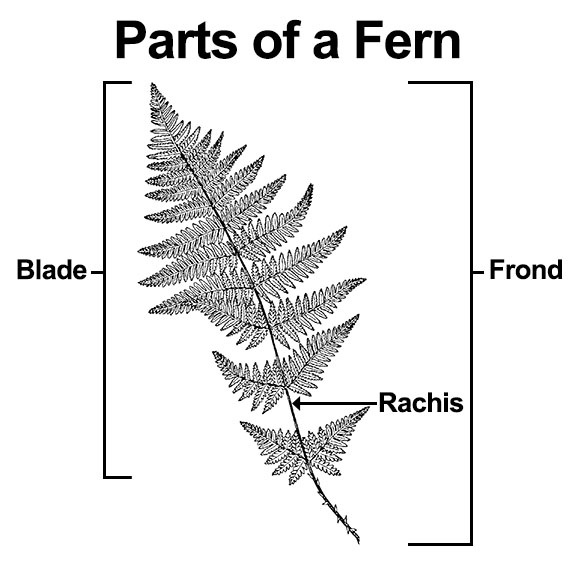 Rachis: The stalk within the blade (the expanded, leafy part of the frond).
Rachis: The stalk within the blade (the expanded, leafy part of the frond).
The nonscientific name "Maidenhair" is said to come from the black roots growing from the rootstock, supposedly suggesting hair. This fern is also referred to as Northern Maidenhair, Maidenhair Fern, Maidenhair, and American Maiden-hair.
Identification of Maidenhair Ferns
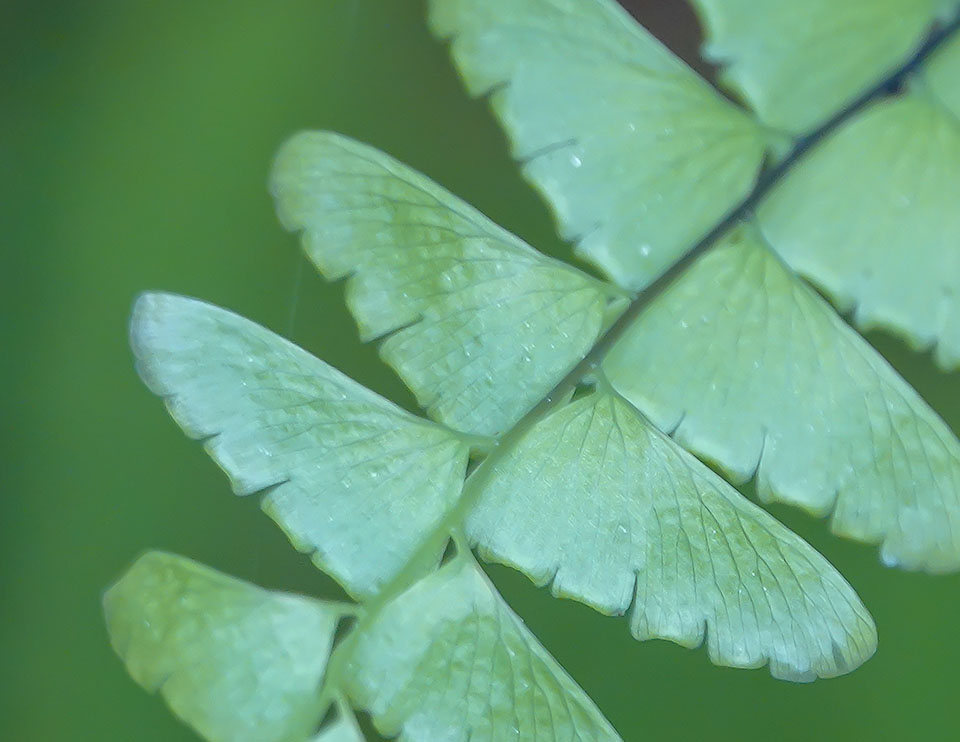
Maidenhair Fern is a deciduous perennial plant up to two feet across. It is a graceful, delicate fern that looks like it is floating in mid-air above the forest floor. Both the rachis Rachis: The stalk within the blade (the expanded, leafy part of the frond). (the stalk within the blade) and the stipe
Rachis: The stalk within the blade (the expanded, leafy part of the frond). (the stalk within the blade) and the stipe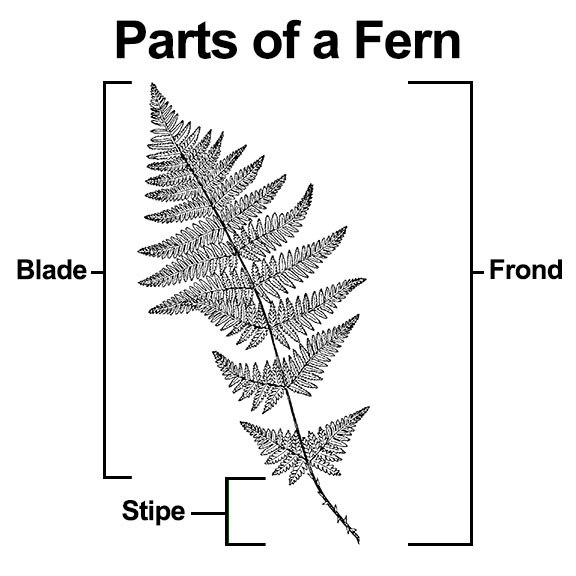 Stipe: The stalk below the blade (the expanded, leafy part of the frond). (the stalk below the blade) are black to purple-brown at maturity.
Stipe: The stalk below the blade (the expanded, leafy part of the frond). (the stalk below the blade) are black to purple-brown at maturity.
The fronds Frond: The whole leaf of a fern. It includes the blade (the expanded leafy part of the frond) and the stipe (the stalk below the blade). (sometimes called leaves)
arise in clusters from creeping, gray-brown rhizomes
Frond: The whole leaf of a fern. It includes the blade (the expanded leafy part of the frond) and the stipe (the stalk below the blade). (sometimes called leaves)
arise in clusters from creeping, gray-brown rhizomes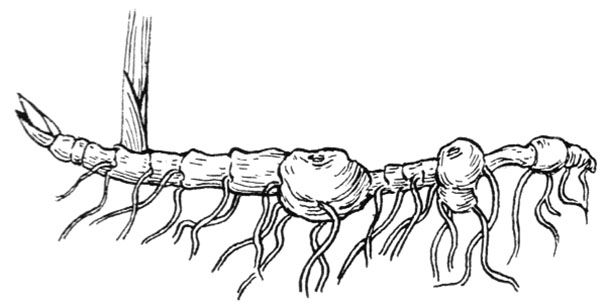 Rhizome: The modified subterranean stem of a plant that sends out roots and shoots from its nodes. Rhizomes are also called creeping rootstalks and rootstocks. (rootstock) which are woody and stout, with light brown scales. The fiddleheadsFiddlehead: The unfurling young frond of true ferns, which loosely resembles the ornate, curled end of a fiddle. (Synonym=crosier) emerge early in the spring. They are wine red, delicate in appearance, and covered in wiry hairs.
Rhizome: The modified subterranean stem of a plant that sends out roots and shoots from its nodes. Rhizomes are also called creeping rootstalks and rootstocks. (rootstock) which are woody and stout, with light brown scales. The fiddleheadsFiddlehead: The unfurling young frond of true ferns, which loosely resembles the ornate, curled end of a fiddle. (Synonym=crosier) emerge early in the spring. They are wine red, delicate in appearance, and covered in wiry hairs.
The bluish-green fronds are 16-26 inches long. They are not dimorphicFrond dimorphism: Refers to a difference in ferns between the fertile and sterile fronds.; the fertile and sterile fronds of Maidenhair Fern are similar in appearance. The fronds are curving, branching and flat, creating a horseshoe-like or circular appearance. The fronds shed water, leaving a smooth surface.
The blade Blade: The expanded, leafy part of the frond. (the leafy part of the frond) is divided into oblong pinnae
Blade: The expanded, leafy part of the frond. (the leafy part of the frond) is divided into oblong pinnae Pinna: A primary division of the blade (plural: pinnae)., each two to seven inches long. Each pinna is divided into pinnules
Pinna: A primary division of the blade (plural: pinnae)., each two to seven inches long. Each pinna is divided into pinnules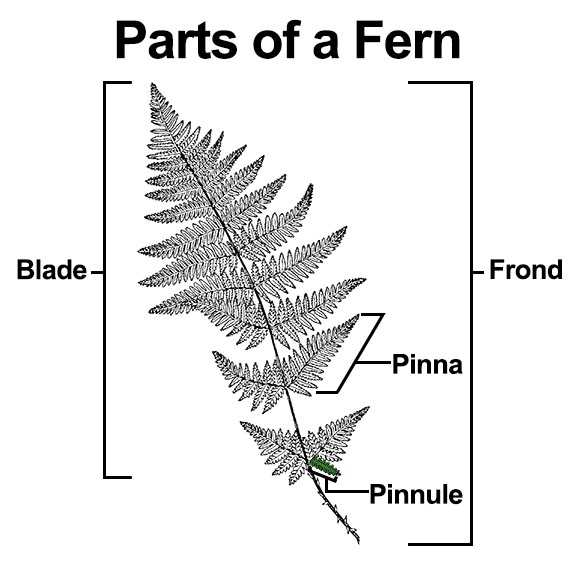 Pinnule: A division of the pinna., which vary in shape from oblong to fan-shaped at the tip of the pinnae
Pinnule: A division of the pinna., which vary in shape from oblong to fan-shaped at the tip of the pinnae Pinna: A primary division of the blade (plural: pinnae).. The marginsThe structure of the leaf's edge. (edges) of each pinnule are smooth on one side, but the other side is incised into lobes separated by shallow incisions. The veins
Pinna: A primary division of the blade (plural: pinnae).. The marginsThe structure of the leaf's edge. (edges) of each pinnule are smooth on one side, but the other side is incised into lobes separated by shallow incisions. The veins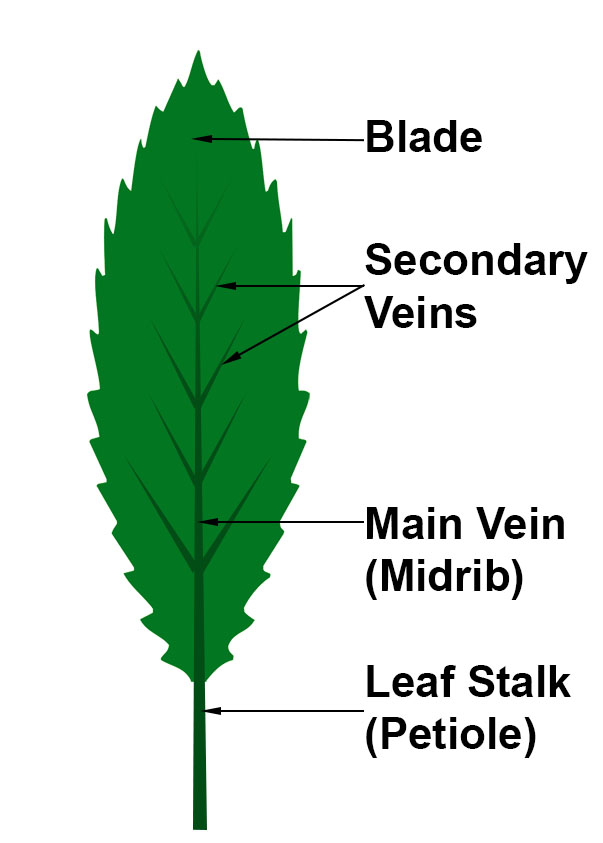 Vein: A vessel that conducts nutrients, sugars, and other substances throughout plant tissues; usually associated with leaves. The arrangement of veins in a leaf is called the venation pattern. on the pinnules are forked two to three times.
Vein: A vessel that conducts nutrients, sugars, and other substances throughout plant tissues; usually associated with leaves. The arrangement of veins in a leaf is called the venation pattern. on the pinnules are forked two to three times.
The sporangiaSporangium: Spore cases inside which the spores develop. (plural = sporangia) (spore-bearing structures) are located near the lobed tips of the leaflets. These tips fold downward, partially covering the sporangia. The spores are released during the summer and fall to be distributed by the wind.
Uses of Maidenhair Ferns
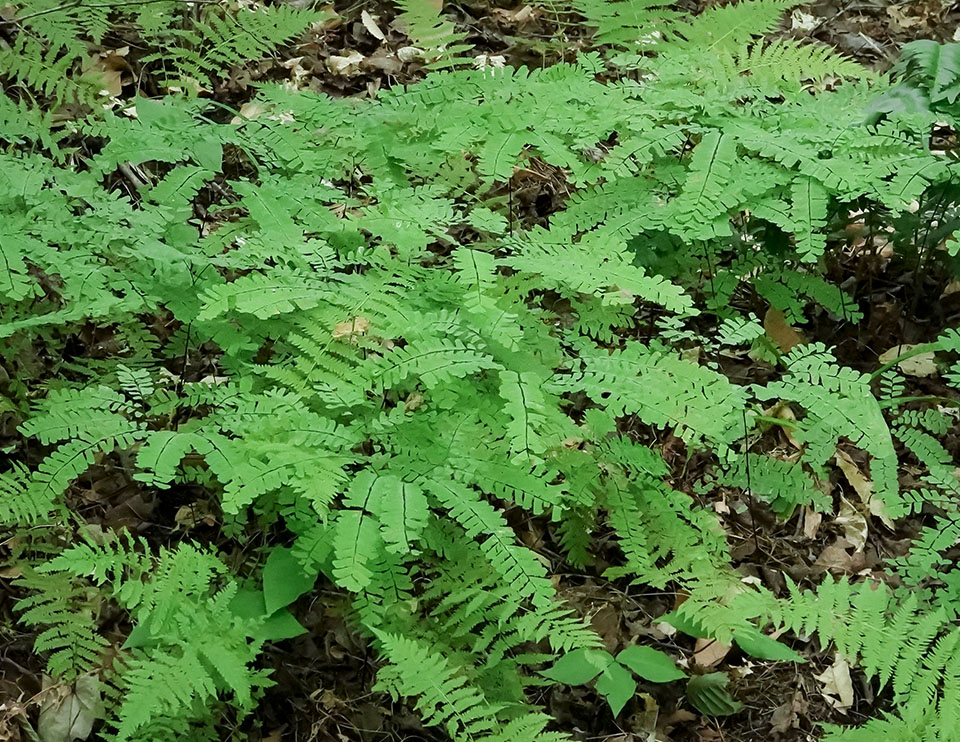
Reports of toxicity for the species could not be found, but experts advise caution because some ferns contain carcinogens. In any event, Maidenhair Fern was highly valued as a medicinal plant by some 19th century practitioners. It was used in the form of a tea or syrup to treat nasal congestion, asthma, and sore throat.
Native American groups also made use of the medicinal properties of the plant. The Cherokee, for instance, applied a compound decoction of root for rheumatism. They also used a decoction of the whole plant as an emetic in cases of fever and smoked the powered leaves for heart trouble and asthma. Other groups used an infusion of dried fronds as a remedy for shortness of breath. The Iroquois used a decoction of the plant for cramps in children and the green roots as a foot soak for rheumatism. They also used a poultice of wet, smashed fronds to treat snake bites.
The plant has also been used for decorative purposes. One native American group used it to line baskets. The plant was also used as decoration on clothing and baskets.
Wildlife Value of Maidenhair Ferns
Information on the wildlife value of Maidenhair Ferns is limited. Several species of aphids are reported to suck the plant juices from this plant. It is also said to provide shelter for toads and lizards.
Distribution of Maidenhair Ferns
Maidenhair Fern is found in the eastern half of the US. It occurs from Minnesota to Maine, south to Georgia and Louisiana, and west to Oklahoma. In Canada, Maidenhair Ferns range from Nova Scotia to Ontario.
Maidenhair Fern is found in all counties within New York State, where it is listed as exploitably vulnerable. Vouchered specimens have been registered for all Adirondack Park Blue Line counties.
Habitat of Maidenhair Ferns
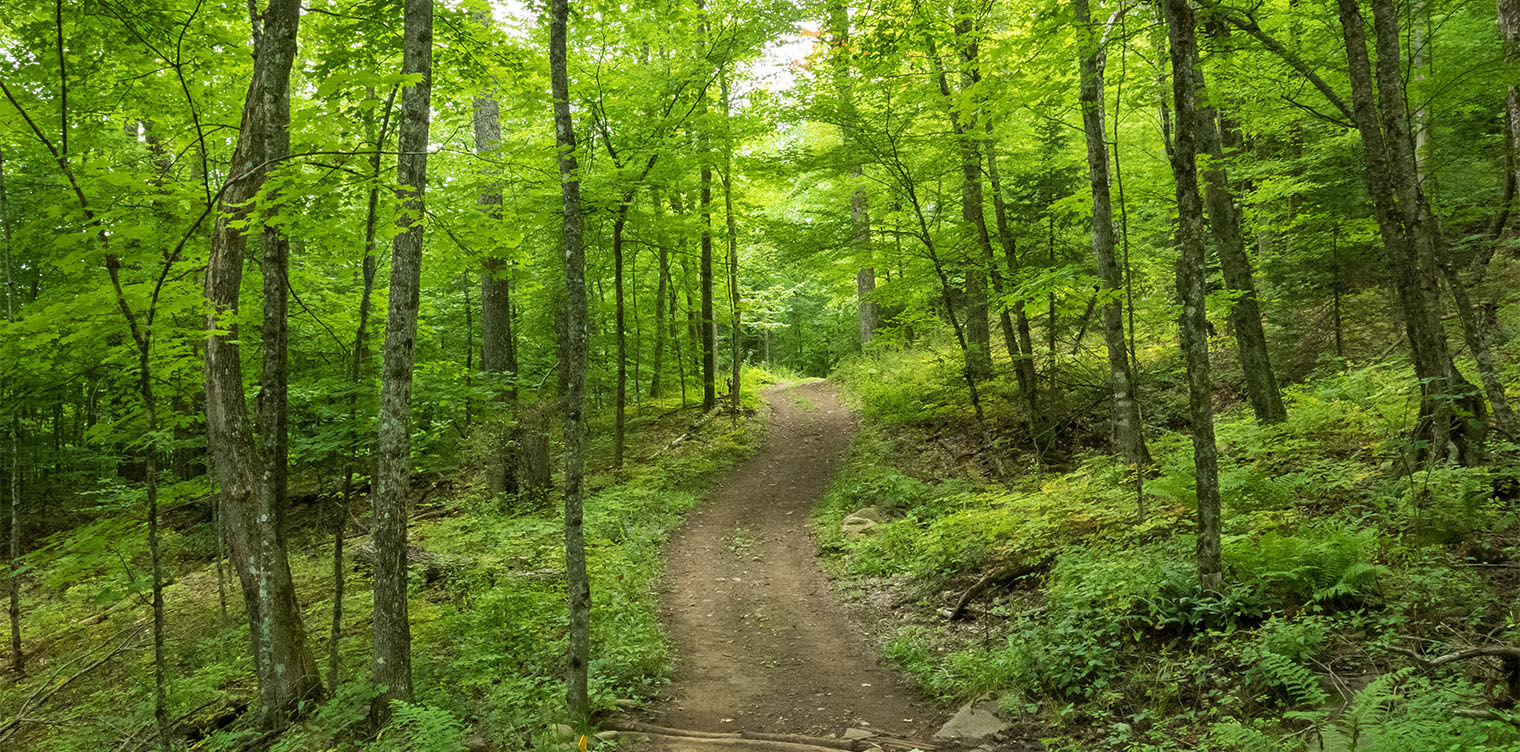
Maidenhair Fern is classified as a Facultative Upland (FACU) plant, meaning that is usually occurs in non-wetlands, but may occur in wetlands. Throughout its range Maidenhair Fern is found in rich, deciduous woodlands, rocky slopes, shaded ravines, and the bottoms of damp, rocky banks. This fern can grow in a range of soils, but is said to be most abundant in moist, rich, neutral to slightly alkaline soil.
In the Adirondacks, Maidenhair Fern is often found growing under Sugar Maple, White Ash, and Basswood in high humus soils. It occurs in several ecological communities, but is more common in rich forests including maple-basswood rich mesic forest.
Among the trails covered here, look for Maidenhair Ferns in northern hardwood forests growing under Sugar Maple on sites that also host Squirrel Corn, Dutchman's Britches, and Early Blue Cohosh.
List of Adirondack Ferns
References
Michael Kudish. Adirondack Upland Flora: An Ecological Perspective (The Chauncy Press, 1992), pp. 60, 82.
Boughton Cobb. A Field Guide to Ferns and their Related Families. Northeastern and Central North America. Second Edition (Houghton Mifflin Company, 2005), pp. 54-57.
Michael Burgess. A Field Guide to the Ferns of New England and Adjacent New York, p. 36-37. Undated. Retrieved 16 February 2017.
Richard Mitchell. Atlas of New York State Ferns (New York State Museum, 1984), p. 7. Retrieved 15 February 2017.
Eugene C. Ogden. Field Guide to Northeastern Ferns (New York State Museum, 1981), p. 38, Plate 1. Retrieved 15 February 2017.
William J. Cody and Donald M. Britton. Ferns and Fern Allies of Canada (Research Branch. Agriculture Canada, 1989), pp. 157-164. Retrieved 19 February 2017.
William J. Cody. Ferns of the Ottawa District (Research Branch. Agriculture Canada, 1978), pp. 101- 103. Retrieved 10 January 2018.
David B. Lellinger. A Field Manual of the Ferns & Fern Allies of the United States and Canada (Smithsonian Institution Press, 1985), pp. 173-179, Plate 209.
Edgar T. Wherry. The Fern Guide. Northeastern and Midland United States and Adjacent Canada (Doubleday & Company, Inc., 1961), pp. 176-177. Retrieved 23 February 2020.
William Cullina. Native Ferns, Moss & Grasses (Houghton Mifflin Company, 2008), p. 33.
Anne C. Hallowell and Barbara G. Hallowell. Fern Finder. Second Edition (Nature Study Guild Publishers, 2001), p. 23.
George Henry Tilton. The Fern Lover's Companion. A Guide for the Northeastern States and Canada (Little, Brown, 1923), pp. 16-17. Retrieved 10 January 2018.
Daniel Cady Eaton and J.H. Emerton. Beautiful Ferns (Estes and Lauriat, 1886), pp. 2-5. Retrieved 21 February 2020.
New York Flora Association. New York Flora Atlas. Maidenhair fern. Adiantum pedatum L. Retrieved 21 February 2020.
Integrated Taxonomic Information System. Adiantum. Retrieved 21 February 2020.
Integrated Taxonomic Information System. Adiantum pedatum L. Retrieved 21 February 2020.
United States Department of Agriculture. The Plants Database. Northern Maidenhair. Adiantum pedatum L. Retrieved 21 February 2020.
Flora of North America. Adiantum. Retrieved 24 February 2020.
Flora of North America. Northern Maidenhair. Adiantum pedatum. Retrieved 21 February 2020.
NatureServe Explorer. Online Encyclopedia of Life. Northern Maidenhair Fern. Adiantum pedatum. Retrieved 21 February 2020.
iNaturalist. Adirondack Park Observations. Northern Maidenhair Fern. Adiantum pedatum. Retrieved 21 February 2020.
Native Plant Trust. Go Botany. Northern Maidenhair Fern. Adiantum pedatum L. Retrieved 21 February 2020.
New York State. Department of Environmental Conservation. New York Natural Heritage Program. Ecological Communities of New York State. Second Edition (March 2014), pp. 120-121. Retrieved 17 October 2015.
New York Natural Heritage Program. 2020. Online Conservation Guide for Maple-Basswood Rich Mesic Forest. Retrieved 21 February 2020.
New York State. Adirondack Park Agency. Preliminary List of Species Native Within the Adirondack Park Listed Alphabetically by Scientific Name and Sorted by Habit. Volume 1. Updated 10.23.2006, p. 57. Retrieved 26 January 2017.
Connecticut Botanical Society. Maidenhair Fern. Adiantum pedatum L. Retrieved 21 February 2020.
University of Wisconsin. Flora of Wisconsin. Adiantum pedatum L. Retrieved 21 February 2020.
Minnesota Wildflowers. A Field Guide to the Flora of Minnesota. Maidenhair Fern. Adiantum pedatum. Retrieved 21 February 2020.
Illinois Wildflowers. Grasses, Sedges, & Non-Flowering Plants. Maidenhair Fern. Adiantum pedatum. Retrieved 21 February 2020.
Eloise Butler Wildflower Garden. The Friends of the Wild Flower Garden. Northern Maidenhair Fern. Adiantum pedatum L. Retrieved 21 February 2020.
Lady Bird Johnson Wildflower Center. Adiantum pedatum. Retrieved 21 February 2020.
Plants for a Future. Plant name. Adiantum pedatum L. Retrieved 21 February 2020
Steven Foster and James A. Duke. A Field Guide to Medicinal Plants and Herbs of Eastern and Central North America. Second Edition. (Houghton Mifflin Harcourt, 2000), pp. 346-347. Retrieved 21 February 2020.
University of Michigan. Native American Ethnobotany. A Database of Foods, Drugs, Dyes and Fibers of Native American Peoples, Derived from Plants. Northern Maidenhair. Adiantum pedatum L. Retrieved 21 February 2020.
Allen J. Coombes. Dictionary of Plant Names (Timber Press, 1994), p. 5.
Charles H. Peck. Plants of North Elba. (Bulletin of the New York State Museum, Volume 6, Number 28, June 1899), p. 153. Retrieved 22 February 2017.
"What the Latin Name Means II," American Fern Journal, Volume 11, Number 1 (January-March 1921), pp. 25-27. Retrieved 10 January 2018.
